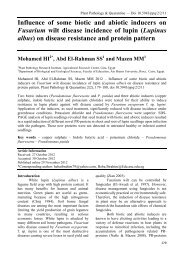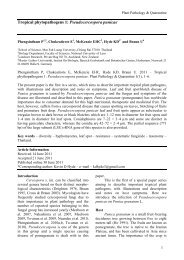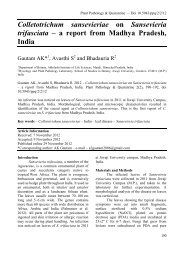Genus Cercospora in Thailand: Taxonomy and Phylogeny (with a ...
Genus Cercospora in Thailand: Taxonomy and Phylogeny (with a ...
Genus Cercospora in Thailand: Taxonomy and Phylogeny (with a ...
You also want an ePaper? Increase the reach of your titles
YUMPU automatically turns print PDFs into web optimized ePapers that Google loves.
Fig. 59 – L<strong>in</strong>e draw<strong>in</strong>gs of <strong>Cercospora</strong><br />
scharifii on Rosa hybrida. a. Conidia. b.<br />
Conidiophores. Bars: a = 25 μm, b = 50 μm.<br />
(Meeboon 2009).<br />
C. apii s. lat. This species was first reported<br />
from <strong>Thail<strong>and</strong></strong> by Meeboon (2009).<br />
Literature – Hsieh & Goh (1990, p. 327–<br />
329).<br />
Rosaceae<br />
<strong>Cercospora</strong> scharifii Petr., Sydowia 10: 14<br />
(1957) [1956]. Fig. 59<br />
Leaf spots 3–8 mm diam., amphigenous,<br />
circular to subcircular, brown, <strong>with</strong> dark brown<br />
to blackish marg<strong>in</strong>. Caespituli amphigenous.<br />
Stromata lack<strong>in</strong>g. Conidiophores 30.5–141 ×<br />
3–5 μm, 4–9 <strong>in</strong> loose fascicules, 1–6-septate,<br />
aris<strong>in</strong>g from stomata, straight to decumbent,<br />
unbranched, cyl<strong>in</strong>drical, smooth, brown at the<br />
base, paler toward the apex, geniculate, mostly<br />
near the apex. Conidiogenous cells <strong>in</strong>tegrated,<br />
term<strong>in</strong>al or <strong>in</strong>tercalary, sympodially proliferat<strong>in</strong>g.<br />
Conidiogenous loci 1.5–2.5 μm diam.,<br />
conspicuous, thickened <strong>and</strong> darkened. Conidia<br />
25–38.5 × 3.5 μm, solitary, obclavate, straight,<br />
hyal<strong>in</strong>e, 4–5-septate, smooth, obconically truncate<br />
at the base, taper<strong>in</strong>g toward a subacute<br />
apex, hila 1.5–2 μm diam., thickened <strong>and</strong><br />
darkened.<br />
Specimen exam<strong>in</strong>ed – THAILAND,<br />
Chiang Mai Prov<strong>in</strong>ce, Mae Jam District, Mae<br />
76<br />
Hae Royal Project Area, on leaves of Rosa<br />
hybrida E.H. L. Krause (Rosaceae), 12<br />
February 2008, Jamjan Meeboon <strong>and</strong> Iman<br />
Hidayat (BBH 23671).<br />
Hosts – Rosa sp., Rosa hybrida<br />
(Rosaceae) (Crous & Braun 2003, Meeboon<br />
2009).<br />
Distribution – Iran, <strong>Thail<strong>and</strong></strong> (Crous &<br />
Braun 2003, Meeboon 2009).<br />
Notes – <strong>Cercospora</strong> scharifii was first<br />
reported from <strong>Thail<strong>and</strong></strong> by Meeboon (2009).<br />
Rubiaceae<br />
<strong>Cercospora</strong> coffeicola Berk. & M.A. Curtis,<br />
Grevillea 9: 99 (1881).<br />
= <strong>Cercospora</strong> coffeae Zimm., Ber.<br />
L<strong>and</strong>-Forstw. Deutch-Oatafr. 2: 35 (1904).<br />
= <strong>Cercospora</strong> herrerana Farneti, Atti Ist.<br />
Bot. Univ. Pavia, Ser. 2, 9: 37 (1911). Fig. 60<br />
Leaf spots 5–8 mm diam., amphigenous,<br />
circular to subcircular, brown to dark brown,<br />
pale at the center, <strong>with</strong> dark marg<strong>in</strong>. Caespituli<br />
amphigenous. Stromata 16.5–31 μm diam.,<br />
substomatal to <strong>in</strong>traepidermal, small, composed<br />
of a few globose <strong>and</strong> brown-walled cells.<br />
Conidiophores 20–140 × 2.5–5 μm, 9–23 <strong>in</strong><br />
loose to dense fascicules, divergent, 2–7-septate,<br />
aris<strong>in</strong>g from stomata, straight, mostly near<br />
the apex, smooth, brown at the base, paler<br />
toward the apex, unbranched, cyl<strong>in</strong>drical,<br />
geniculate. Conidiogenous cells <strong>in</strong>tegrated,<br />
holoblastic, polyblastic, sometimes monoblastic,<br />
term<strong>in</strong>al or <strong>in</strong>tercalary, sympodially<br />
proliferat<strong>in</strong>g. Conidiogenous loci 2–2.5 μm<br />
diam., conspicuous, thickened <strong>and</strong> darkened.<br />
Conidia 35–178 × 3–4 μm, solitary, obclavate,<br />
straight, slightly curved, hyal<strong>in</strong>e, 4–21-septate,<br />
smooth, obconically truncate at the base, taper<strong>in</strong>g<br />
toward a subacute apex, hila 2–2.3 μm<br />
diam., thickened <strong>and</strong> darkened.<br />
Specimen exam<strong>in</strong>ed – THAILAND,<br />
Chiang Mai Prov<strong>in</strong>ce, Mae Jam District, Mae<br />
Hae Royal Project Area, on leaves of Coffea<br />
arabica L. (Rubiaceae), 12 February 2008,<br />
Jamjan Meeboon <strong>and</strong> Iman Hidayat (BBH<br />
23600).<br />
Hosts – Coffea arabica, C. canephora, C.<br />
excelsa, C. laur<strong>in</strong>a, C. liberica, C. robusta, C.<br />
stenophylla, Coffea spp. (Rubiaceae) (Crous &<br />
Braun 2003).









